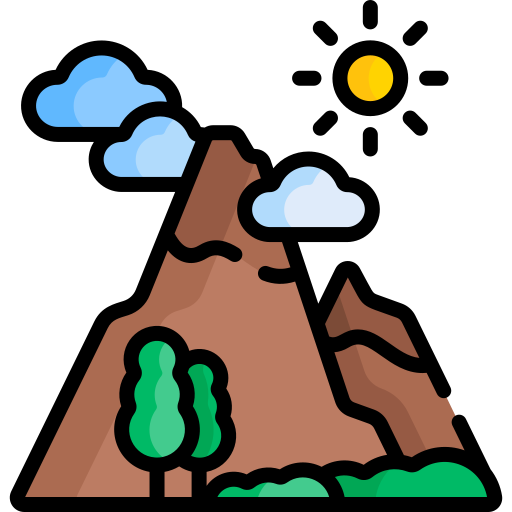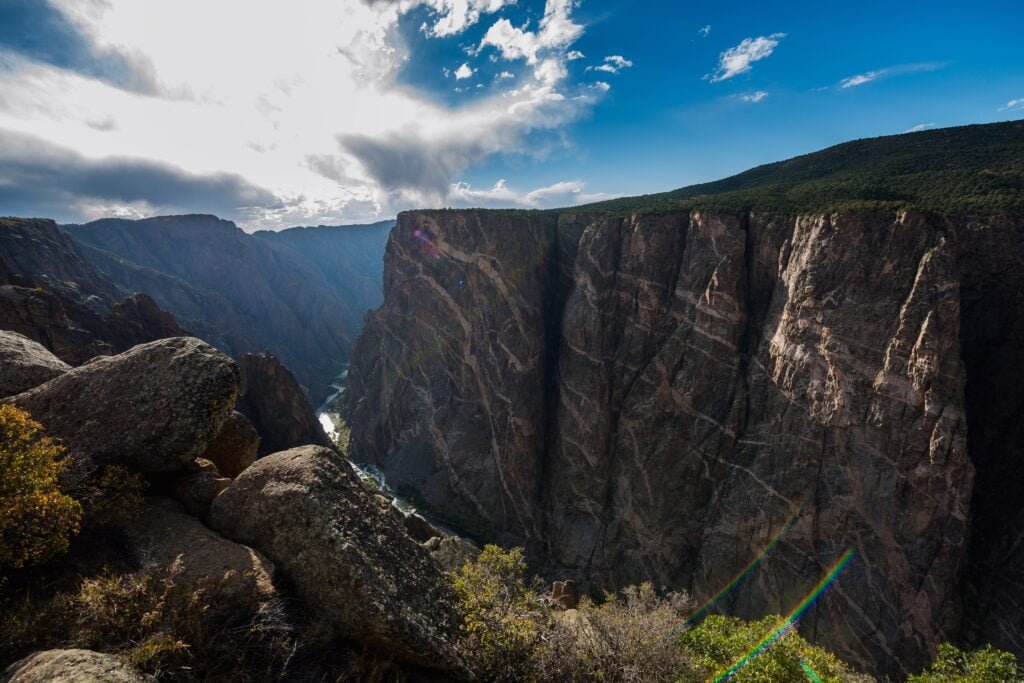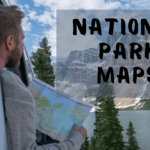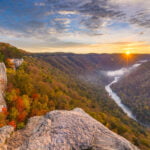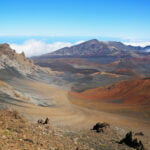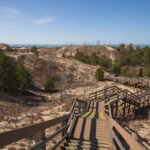Black Canyon of the Gunnison National Park
Black Canyon of the Gunnison National Park, a standout among America’s national parks with its stunning views, exciting outdoor activities, and a deep connection to nature. Located in western Colorado, this park features one of the most spectacular canyons in the country. The canyon’s walls drop nearly 2,700 feet to the Gunnison River, creating an impressive sight that fills visitors with awe.
The park’s main goal is to protect its distinctive geological and ecological characteristics while offering visitors chances to explore, learn, and have fun. The Black Canyon is unique, with its narrow and steep walls hosting a diverse range of plants and animals and remarkable geological formations that narrate the Earth’s history.
Black Canyon of the Gunnison offers a variety of attractions and activities, including scenic drives, hiking trails of varying difficulty, rock climbing, fishing, and opportunities to watch wildlife. For a deeper appreciation of the park’s beauty, there are ranger-led programs and stargazing events, thanks to its status as an International Dark Sky Park.
Whether you’re looking for adventure or a peaceful retreat into nature, Black Canyon of the Gunnison National Park delivers an exceptional experience, highlighting the magnificent force of nature and the importance of preserving these untouched landscapes for future generations.
Location of Black Canyon of the Gunnison National Park
Black Canyon of the Gunnison National Park is a breathtaking geological marvel situated in the western part of the state of Colorado in the United States. The park encompasses a stunning 30,750-acre area, showcasing the dramatic depths and striking beauty of the Gunnison River as it carves its way through the rugged landscape.
Directions to Black Canyon of the Gunnison National Park
Black Canyon of the Gunnison National Park is located in western Colorado. To get there:
- From Montrose, CO: Take US-50 E for about 15 miles. Turn right onto CO-347 N and follow it for 7 miles to the park entrance.
For GPS navigation, use: 9800 Highway 347, Montrose, CO 81401.
Coordinates of Black Canyon of the Gunnison National Park
- Latitude: 38°34′45″N
- Longitude: 107°43′39″W
Scenery Black Canyon of the Gunnison National Park
This awe-inspiring canyon is characterized by its steep cliffs and narrow, deep gorges, some reaching depths of over 2,700 feet. The park’s most iconic feature is the dark-colored Precambrian gneiss and schist rock formations which not only give the canyon its distinct appearance but also lend it its name. These ancient rocks are among the oldest and hardest on Earth, making the canyon an exceptional geological wonder.
The location of the park, along with its diverse topography and elevation, fosters a rich ecological tapestry. The riparian zones along the river support various plant and animal species, while the upland areas provide a home for numerous wildlife, including elk, mule deer, and mountain lions. The park’s higher elevations also host a unique montane ecosystem, characterized by mixed coniferous forests and aspen groves.
Black Canyon’s dramatic terrain and location have had a significant influence on the region’s history, from the Ute Indians who once inhabited the area to the intrepid explorers and settlers who later navigated the treacherous canyon. Today, the park’s varied landscape offers a range of recreational opportunities, from hiking and rock climbing to fishing and wildlife watching. As a result, Black Canyon of the Gunnison National Park continues to captivate visitors with its stunning vistas, rich history, and unparalleled natural beauty.
Black Canyon of the Gunnison National Park Opening Times
Black Canyon of the Gunnison National Park is a breathtaking destination that welcomes visitors year-round. However, it is essential to plan your visit according to the park’s opening hours, which vary depending on the season and specific areas within the park. The South Rim, the most popular and accessible section of the park, is open 24 hours a day, maintaining a year-round schedule. However, the visitor center and campgrounds operate on specific hours, which can be found on the park’s official website.
The North Rim, though equally mesmerizing, is more remote and seasonal. Access to this area is typically available from mid-May through mid-October, depending on weather conditions. Snowfall often leads to road closures, making it essential to check the park’s road status before heading out. The East Portal Road, offering a different perspective of the park, is open between April and November, again subject to weather conditions.
These seasonal variations are in place to ensure visitor safety and preserve the park’s unique ecosystem. Snow and ice during colder months can make the roads and trails treacherous, while wildlife is protected during their most vulnerable times. To make the most of your visit, research the specific areas you’d like to explore and plan accordingly, taking into account the seasonal opening hours and weather conditions.
Visitor Centers and Facilities at Black Canyon of the Gunnison National Park
At Black Canyon of the Gunnison National Park, there are two visitor centers designed to make your visit an enjoyable and informative experience. The South Rim Visitor Center is the main hub and is located near the South Rim entrance of the park. The North Rim Ranger Station, on the opposite side of Black Canyon, serves as a smaller facility with essential amenities and information.
The South Rim Visitor Center offers a wide range of services to park visitors. Here, you will find restrooms, a bookstore, a park film, and indoor exhibits showcasing the park’s geology, ecology, and history. Rangers are available to answer questions and provide recommendations for hikes and overlooks. This visitor center also features a picnic area, making it an ideal spot for a relaxing lunch with breathtaking views of the canyon. The South Rim Visitor Center is open daily, except for some winter holidays.
The more remote North Rim Ranger Station offers limited amenities, including restrooms, information services, and a small bookstore. There are no picnic areas, campgrounds, or playgrounds at this location. Due to its remote nature, the North Rim is less frequented, so it may be a good option for those seeking a more peaceful, solitary experience.
To make the most of your visit, plan to arrive at the visitor centers early in the day. This will give you ample time to explore the various exhibits and gather information from the rangers before setting out to explore the park. Additionally, if you’re planning a picnic, be sure to pack your food and drink essentials, as there are no dining facilities within the park. Lastly, visitors should be aware that the North Rim is closed during the winter months due to its high elevation and snowy conditions, so plan accordingly.
In conclusion, Black Canyon of the Gunnison National Park offers two visitor centers to cater to your informational and basic amenity needs. Make the most of these facilities by arriving early, planning for picnics, and considering the seasonality of the North Rim.
Accessibility at Black Canyon
Black Canyon of the Gunnison National Park is committed to ensuring that all visitors, including those with disabilities or mobility challenges, can experience the beauty and wonder of this unique destination. The park offers a variety of accessible facilities, trails, and viewpoints to cater to varying needs.
The South Rim Visitor Center features accessible restrooms, parking, and interpretive exhibits, making it an excellent starting point for your visit. Additionally, several overlooks along the South Rim Drive, such as Gunnison Point and Pulpit Rock, are wheelchair-accessible, offering stunning views of the canyon.
For those looking to explore the park’s trails, the Rim Rock Nature Trail is a relatively easy, paved path that provides breathtaking vistas and opportunities to observe local flora and fauna. The Cedar Point Nature Trail, though slightly more challenging due to its unpaved surface, offers accessible boardwalks and overlooks that showcase the striking river and canyon scenery.
Visitors requiring additional assistance are encouraged to contact the park’s visitor center for more information on available services, as well as any necessary permits for accessible parking or entry.
It’s important to note that the North Rim, while offering striking views, has limited accessibility due to its remote nature and unpaved roads. The steep and rugged terrain of inner canyon routes and wilderness areas may also present challenges for visitors with mobility concerns. However, with careful planning and consideration of individual needs, a memorable and fulfilling experience can be enjoyed by all at Black Canyon of the Gunnison National Park.
Getting To Black Canyon of the Gunnison National Park
Getting to Black Canyon of the Gunnison National Park is a pleasant journey through the picturesque landscapes of Colorado. The closest commercial airport is Montrose Regional Airport (MTJ), which is approximately 15 miles away from the park entrance. Car rentals are available at the airport; however, public transportation options to the park are limited. To reach the park, consider renting a car or using a shuttle service provided by local hotels.
The nearby towns of Montrose and Gunnison offer convenient starting points for your journey, with Gunnison being about 50 miles away. From Montrose, take US Highway 50 east for approximately 7 miles, and then turn right onto CO Highway 347. Drive 8 miles on this road to reach the South Rim entrance of the park.
Parking is available at multiple locations throughout the park, including the South Rim Visitor Center and various overlooks. There are no fees for parking, but entrance fees apply for entering the park. During peak seasons, such as summer and fall weekends, parking spaces might fill up quickly, so arrive early in the day to secure a spot. Consider visiting the park during weekdays or shoulder seasons for a more relaxed experience and easier parking access.
Black Canyon of the Gunnison National Park Entrance Fees and Passes
A visit to Black Canyon of the Gunnison National Park requires visitors to pay an entrance fee, which helps support the park’s maintenance and preservation efforts. The entrance fees are as follows:
1. Vehicles: $30, valid for 7 consecutive days
2. Motorcycles: $25, valid for 7 consecutive days
3. Individual (hiker, biker, or pedestrian): $15, valid for 7 consecutive days
To obtain these passes, visitors can either pay at the park entrance station or purchase them online via the park’s website. There are several exemptions and discounts available, including fee-free days, which the National Park Service offers on select dates throughout the year.
Additionally, visitors who frequent national parks may benefit from purchasing an annual park pass. The America the Beautiful Pass costs $80 and offers unlimited access to over 2,000 federal recreation sites for a full year. This pass can be an excellent value for avid park-goers, but it may not be worthwhile for those who only visit occasionally.
Senior citizens (aged 62 and above) can take advantage of the Senior Pass, which offers two options: a $20 annual pass or an $80 lifetime pass. Furthermore, active-duty military personnel, veterans, Gold Star families, and U.S. citizens with permanent disabilities can obtain free access passes.
While the entrance fees and park passes help fund essential park services, drawbacks may include limited accessibility for some visitors due to the added costs. However, the fees ultimately contribute to the park’s ability to maintain its natural beauty and provide a memorable experience for all who visit.
Black Canyon of the Gunnison National Park Park Rules and Regulations
At Black Canyon of the Gunnison National Park, it is crucial that visitors adhere to the park rules and regulations to ensure the preservation of its natural beauty, the safety of visitors, and the well-being of wildlife. Responsible behavior is key to maintaining the park’s integrity and protecting its resources for future generations.
One essential rule is to stay on designated trails, as wandering off the path can lead to soil erosion and unintentional damage to the fragile ecosystem. Rock climbing and hiking in closed areas are prohibited, and violators may face fines or penalties.
Feeding or approaching wildlife is another significant violation, as it can alter the animals’ behavior and make them dependent on human interaction. It’s essential to maintain a safe distance from wildlife and secure all food and trash to avoid attracting them.
Camping is only allowed in designated areas, and campfires must be contained in park-provided fire rings or grills. Collecting firewood is not permitted – visitors should bring their own.
To be a responsible park visitor, always respect the park’s rules and guidelines, practice Leave No Trace principles, and report any observed violations to park staff. By doing so, you can ensure that Black Canyon of the Gunnison National Park continues to offer a breathtaking and enjoyable experience for all who visit.
Transportation Within Black Canyon of the Gunnison National Park
Black Canyon of the Gunnison National Park offers a variety of transportation options to cater to different visitor interests and needs. The park’s transportation mostly depends on personal vehicles, park shuttles, and bicycles.
1) Personal Vehicles: Most visitors prefer using their cars or RVs to explore the park. South Rim Road, the main artery of the park, has several scenic overlooks and trailheads. Keep in mind that North Rim Road is a gravel surface with sharp curves, suitable for high-clearance vehicles only. Parking can be limited during peak seasons.
2) Park Shuttles: During peak season, the park operates a shuttle bus service on the South Rim. This environmentally friendly option reduces traffic congestion and helps preserve the park’s fragile ecosystem. The shuttle runs between the visitor center and key points of interest. However, it may not be ideal for those with mobility impairments, as some stops involve short walks.
3) Bicycles: Cycling enthusiasts can ride their bikes on South Rim Road and North Rim Road. Biking offers a sustainable and healthy way to navigate the park while enjoying its breathtaking views. Be advised that cycling on the park’s trails is not allowed, and cyclists must be cautious of vehicular traffic.
When choosing transportation options, consider factors like accessibility, convenience, and sustainability. Families and visitors with limited mobility may prefer personal vehicles, while outdoor enthusiasts and eco-conscious travelers might opt for bicycles or shuttles. No matter which mode of transport you choose, Black Canyon of the Gunnison National Park promises an unforgettable experience.
Attractions at Black Canyon of the Gunnison National Park
Black Canyon of the Gunnison National Park offers a variety of breathtaking vistas and thrilling adventures to its visitors. Here are five must-visit locations within the park that you won’t want to miss:
1. South Rim Drive: This scenic 7-mile drive offers 12 overlooks that provide awe-inspiring views of the canyon’s depths and unique rock formations. The best time to visit is during the summer and fall, as the road is closed during the winter months. One of the most memorable moments from my visit was witnessing a golden sunset from the Painted Wall viewpoint, the tallest cliff in Colorado.
2. North Rim Drive: For a less crowded and more remote experience, the North Rim Drive is your best bet. It features six overlooks and is accessible only by gravel road. Keep in mind that the North Rim is closed during the winter, typically from late November to mid-April. The highlight of this drive is the Exclamation Point, which offers a stunning panorama of the canyon and the Gunnison River below.
3. Gunnison Point: Located near the South Rim Visitor Center, Gunnison Point offers a fantastic introduction to the park’s dramatic landscapes. The best time to visit is during the early morning or late afternoon when the sunlight dances across the canyon walls. I recall feeling a sense of wonder as I gazed out across the vista, marveling at the forces of nature that sculpted this magnificent canyon.
4. Warner Point Nature Trail: This one-mile round trip trail offers a leisurely walk through the park’s diverse vegetation and wildlife. The trail ends at Warner Point, presenting a breathtaking view of the Gunnison River and the San Juan Mountains. The best time to visit is during the spring and summer months when wildflowers paint the landscape with vibrant colors.
5. East Portal Road: This adventurous drive descends 2,000 feet into the canyon’s depths, providing an up-close experience with the Gunnison River. The steep and winding road is not suitable for large RVs or trailers. One of the most rewarding aspects of this drive is the chance to fish in the crystal clear waters of the Gunnison River, teeming with trout. The best time to visit is during the summer when the road is open and river levels are safe for fishing.
Each of these must-visit locations within Black Canyon of the Gunnison National Park offers a unique and unforgettable experience, showcasing the park’s rugged beauty and untamed wilderness. So pack your camera, lace up your hiking boots, and get ready to explore this awe-inspiring natural wonder.
Recreational Activities at Black Canyon of the Gunnison National Park
Trails and Hiking:
Black Canyon of the Gunnison National Park offers a variety of trails and hiking opportunities suitable for all fitness levels. Enjoy breathtaking views of the canyon and immerse yourself in the diverse flora and fauna of the park. The Rim Rock Nature Trail and the Oak Flat Loop Trail are two popular options, providing accessible and moderately challenging experiences, respectively. Remember to wear appropriate footwear, carry plenty of water, and check for seasonal closures. Hiking along the canyon rims is generally safe, but the inner canyon routes are more demanding and require a free Wilderness Use Permit, available at the visitor center.
Climbing:
The park’s steep cliffs attract experienced climbers seeking thrilling and challenging routes. Technical rock climbing requires skill, experience, and appropriate equipment, along with a free climbing permit. It is crucial to adhere to the Leave No Trace principles and practice safe climbing techniques. The climbing season typically lasts from April to October, but always check for current conditions and potential closures.
Cycling:
Cycling enthusiasts can enjoy paved roads, such as the South Rim Road, which offers stunning canyon views. Bicycles are not allowed on trails, and riders must follow traffic regulations and wear helmets. The park’s steep terrain may be challenging for some, but the scenic rewards are worth the effort.
Ranger Programs and Guided Tours:
Expand your knowledge about the park’s natural and cultural history by participating in ranger-led programs. These events range from guided walks and talks to evening campfire programs suitable for all ages. The park also offers private guided tours upon request. No additional permits are required, but advanced reservations are recommended.
Other Activities:
Fishing, wildlife watching, and photography are among the popular activities available at the park. Anglers must possess a valid Colorado fishing license and adhere to state regulations. Wildlife enthusiasts can spot various species of birds, mammals, and reptiles, while photographers can capture the park’s unique landscapes throughout the year.
In conclusion, Black Canyon of the Gunnison National Park offers a range of recreational activities for diverse interests and abilities. Whether you prefer a leisurely stroll along the canyon rim or a thrilling rock climb, there is something for everyone. Always prioritize safety, adhere to park regulations, and cherish the natural beauty of this remarkable destination.
Best Times to Visit Black Canyon of the Gunnison National Park
Black Canyon of the Gunnison National Park offers an unforgettable experience to visitors year-round. However, the best time to visit depends on your preferences and priorities.
Spring (April-May) at the park presents a beautiful sight, with the canyon walls adorned with wildflowers and the river below flowing with vigor from melting snow. But be prepared for unpredictable weather, as snowstorms and rain can be common during this time. This season attracts fewer visitors, which can be ideal if you prefer a more tranquil experience. Due to the unpredictable weather, some facilities and trails may be closed or limited.
Summer (June-August) is the most popular time to visit, with warm temperatures and an abundance of sunshine. Hiking and other outdoor activities are the most enjoyable during this season. However, the park can get crowded, and some trails may be congested. If you’re seeking wildlife sightings, summer is a great time for birdwatching and spotting various mammals that inhabit the park.
Fall (September-October) brings cooler temperatures and vibrant foliage, making it a spectacular time to enjoy the park’s beauty. The crowds tend to thin out compared to summer, and wildlife sightings, especially of elk and deer, are more common. This season is perfect for photography enthusiasts and those who enjoy crisp autumn air.
Winter (November-March) is the least visited time of the year, but the snow-covered canyon offers a unique and serene experience. Cross-country skiing and snowshoeing are popular activities during this time. However, most facilities are closed, and access to certain areas of the park can be limited due to snowfall and road closures.
In summary, if you prioritize warm temperatures and don’t mind crowds, summer is the best time to visit. For those seeking solitude and cooler temperatures, spring and fall are ideal. Winter adventures await those who appreciate snow-covered landscapes and don’t mind limited facility availability. No matter the season, Black Canyon of the Gunnison National Park offers a breathtaking experience for all.
Nearby Attractions to Black Canyon of the Gunnison National Park
Surrounding the awe-inspiring Black Canyon of the Gunnison National Park, visitors can find an array of exciting attractions and activities to include in their itinerary. Here are three nearby attractions that are definitely worth exploring.
Firstly, the Curecanti National Recreation Area is an excellent spot for water enthusiasts. Located just 20 minutes west of the park, this area is highlighted by the Blue Mesa Reservoir, Colorado’s largest body of water. It’s an ideal destination for fishing, boating, and swimming. The recreation area also offers scenic drives, hiking trails, and opportunities for wildlife viewing. There is no entrance fee, but fees for camping and boating permits apply.
Another fascinating attraction is the Gunnison Pioneer Museum, situated in the town of Gunnison, approximately 25 miles southeast of the park. This museum provides a glimpse into the rich history of the region, showcasing artifacts, machinery, and preserved buildings from the late 1800s and early 1900s. While the museum is open daily from May to September, hours vary by season. Admission fees are $10 for adults, $9 for seniors, and free for children under 12.
Lastly, the Crested Butte Mountain Resort, about 60 miles northeast of the park, is perfect for thrill-seekers and nature lovers alike. This popular ski resort offers a wide range of winter activities such as skiing, snowboarding, and snowshoeing. During the summer, visitors can enjoy mountain biking, hiking, and scenic chairlift rides. Hours and fees vary depending on the activity and season, so it’s best to check their website for the latest information.
While these attractions add variety and excitement to a trip to Black Canyon of the Gunnison National Park, it’s important to consider the additional time and expenses they may involve. Balancing the park’s natural beauty with these nearby attractions will help create a well-rounded and memorable Colorado adventure.
Tips for Visiting Black Canyon of the Gunnison National Park
Black Canyon of the Gunnison National Park, known for its dramatic landscapes and thrilling outdoor adventures, offers a remarkable experience for visitors. To make the most of your trip, consider these valuable tips.
The best time to visit the park is from late May to early October when the weather is mild, and all the facilities are open. During this season, you can witness the vibrant display of wildflowers and spot diverse wildlife, such as elk, mule deer, and golden eagles. However, if you prefer a more peaceful experience, choose the shoulder seasons of spring or fall, when the park is less crowded.
Packing essentials include sturdy hiking shoes, layered clothing, sunscreen, a hat, sunglasses, water bottles, and high-energy snacks. A good quality camera with wide-angle and telephoto lenses is advisable to capture the stunning canyon views, dramatic rock formations, and impressive wildlife.
Photography enthusiasts should visit popular viewpoints, such as Painted Wall and Sunset View, during the golden hours to capture the canyon’s magnificent hues. Experiment with different angles to showcase the canyon’s depth and the narrowness of the Gunnison River.
Safety precautions are crucial, especially when exploring the canyon’s rugged terrain. Stay on marked trails, maintain a safe distance from cliff edges, and observe posted warnings. Dehydration and altitude sickness are potential hazards, so it’s essential to stay well-hydrated and acclimatize before embarking on challenging hikes. If you’re planning to rock climb or kayak, it is highly recommended that you have prior experience and use appropriate safety gear.
Recommended itineraries vary based on the duration of your stay and interests. For a day visit, explore the South Rim Drive, which features 12 overlooks and several short trails, such as the Oak Flat Loop and Warner Point Nature Trail. If you have more time, venture to the North Rim for a more secluded experience and catch breathtaking views from Exclamation Point. For adventurous visitors, consider exploring the thrilling Inner Canyon routes or embarking on a multi-day backpacking trip through the stunning wilderness.
Camping and Lodging at Black Canyon of the Gunnison National Park
Black Canyon of the Gunnison National Park offers a range of accommodations to suit various preferences, budgets, and group sizes. Options include campgrounds within the park, nearby hotels, and vacation rentals.
Within the park, there are two campgrounds: South Rim Campground and North Rim Campground. South Rim has 88 campsites and offers amenities such as flush toilets, drinking water, and picnic tables. It operates on a first-come, first-served basis, and sites cost around $16 – $24 per night. North Rim Campground has 13 sites with vault toilets, picnic tables, and fire grates, but no water. These sites are more secluded, cost around $16 per night, and require a reservation. Camping within the park allows for easy access and immersion in the natural environment but may lack some of the creature comforts of other accommodations.
For those looking for more comfortable lodging, there are hotels and motels available in nearby towns such as Montrose and Gunnison. The price range for these options varies depending on the star rating and amenities, with prices typically ranging from $80 – $200 per night. Hotels offer the advantage of more amenities, such as air conditioning and private bathrooms, but may be less convenient for accessing the park.
Vacation rentals, such as cabins and private homes, are also an option for visitors seeking a more personalized and spacious accommodation. These rentals can be booked on websites like Airbnb and Vrbo and offer a unique experience tailored to your preferences. Prices for vacation rentals vary greatly, from $100 to several hundred dollars per night, depending on the size and location.
In summary, campgrounds within the park are best for visitors seeking an immersive experience and budget-friendly option, while hotels and vacation rentals provide more comfort and amenities at varied price points. Regardless of your choice, book in advance to secure your preferred accommodation and enjoy the majestic beauty of Black Canyon of the Gunnison National Park.
Food and Dining Options Black Canyon of the Gunnison National Park
Black Canyon of the Gunnison National Park offers a variety of food and dining options to suit the tastes and budgets of its visitors. While there are no full-service restaurants within the park itself, there are some convenient on-site facilities to cater to your hunger. The South Rim Campground features a camp store that sells pre-packaged food, snacks, and beverages – perfect for those who prefer a quick grab-and-go option.
For a more leisurely dining experience, several nearby restaurants can be found in the surrounding towns of Montrose, Hotchkiss, and Crawford. These establishments offer a diverse range of cuisines, from traditional American fare to Mexican and Italian dishes. Prices vary depending on the restaurant, so there’s something for every budget.
If you prefer a scenic outdoor meal, the park’s numerous picnic areas provide the perfect setting for a self-catered lunch. Be sure to pack your own food and drinks, as well as a portable cooler to keep everything fresh. This option is not only budget-friendly, but it also allows for greater flexibility in catering to specific dietary preferences, such as vegetarian, vegan, or gluten-free diets.
In summary, while the park itself may not offer a wide array of dining options, the nearby towns and beautiful picnic areas ensure that visitors will not go hungry during their stay at Black Canyon of the Gunnison National Park. No matter your culinary preferences or budget restrictions, you’ll find something to satisfy your appetite while exploring this breathtaking landscape.
Visitor Numbers Black Canyon of the Gunnison National Park
Visitor numbers and trends at Black Canyon of the Gunnison National Park present an interesting pattern over the years, which can inform your trip planning. The park’s peak visiting season typically falls between June and August, with visitors flocking to witness the dramatic cliffs and awe-inspiring views. However, visitor numbers have fluctuated significantly in recent years, showcasing the impact of external factors such as weather, special events, school holidays, and even global pandemics like COVID-19.
Over the span of a decade from 2010 to 2020, visitor numbers showed an overall increase, rising from 176,344 in 2010 to a high of 432,818 in 2019. This trend illustrates the growing popularity of the park, possibly driven by increased awareness and improved facilities.
However, the COVID-19 pandemic in 2020 led to a sharp drop in visitor numbers, down to 341,620, as global travel restrictions and safety concerns limited the park’s accessibility. Even as the world gradually adapted to the pandemic situation, visitor numbers in 2021 and 2022 remained lower than the pre-pandemic peak, at 308,910 and 297,257 respectively. This could be attributed to the lingering effects of the pandemic, changing travel preferences, and people’s inclination towards less crowded destinations. Visitor numbers are from the official NPS database.
| Year | Recreation Visits |
|---|---|
| 2015 | 209,166 |
| 2016 | 238,018 |
| 2017 | 307,143 |
| 2018 | 308,962 |
| 2019 | 432,818 |
| 2020 | 341,620 |
| 2021 | 308,910 |
| 2022 | 297,257 |
Visiting during the shoulder seasons of May and September can offer a less crowded experience at the park. These months offer mild weather and showcase the vibrant colors of spring wildflowers or the glorious fall foliage. Another strategy to avoid crowds is to arrive early in the day or explore less popular trails within the park.
Despite fluctuating visitor numbers, there are plenty of ways to make the most of your trip to this stunning park. Be it enjoying the picturesque overlooks, hiking the scenic trails, or learning about the park’s geology, wildlife, and history at the visitor center. By planning your visit with these factors in mind, you can ensure a memorable and enjoyable experience at Black Canyon of the Gunnison National Park.
History and Background of Black Canyon of the Gunnison National Park
Nestled within western Colorado, Black Canyon of the Gunnison National Park boasts a rich history that has shaped its present allure and significance. The stunning gorge was formed over two million years ago as the Gunnison River slowly carved through the Precambrian rock, creating a dramatic landscape with some of the steepest cliffs, oldest rock formations, and craggiest spires in North America. The Ute Indians were the first inhabitants of the region, utilizing the canyon for hunting and gathering.
In the late 19th century, European explorers, including John Williams Gunnison, ventured into the area, leading to its recognition among settlers. The canyon’s name is derived from Gunnison and the fact that its sheer walls allow very little sunlight to penetrate, rendering the canyon dark, or “black.”
In 1933, the Black Canyon was designated a national monument by President Herbert Hoover, and later, in 1999, it was finally elevated to national park status. This change helped initiate preservation and restoration efforts to ensure that the park remains a pristine haven for future generations. The National Park Service now oversees the park’s protection, focusing on maintaining the natural habitat, preventing human-caused erosion, and promoting responsible recreational activities.
Today, Black Canyon of the Gunnison National Park is valued not only for its awe-inspiring landscape but also for its cultural and educational offerings. The park provides visitors with insights into the geological processes that sculpted this natural wonder, as well as the cultural history of the Ute Indians and European explorers. The park’s visitor center showcases exhibits on the canyon’s geology, flora, fauna, and human history, while ranger-guided programs and special events offer in-depth learning experiences. With its remarkable beauty and fascinating history, Black Canyon of the Gunnison National Park is truly a remarkable destination for anyone seeking to explore and appreciate the wonders of the natural world.
Flora and Fauna at Black Canyon of the Gunnison National Park
Black Canyon of the Gunnison National Park is a haven for diverse wildlife and plant species, with its unique ecosystems and habitats providing a rich environment for countless flora and fauna. The park is home to a variety of ecosystems, ranging from the deep, narrow canyon with its sheer cliffs and rocky slopes to the expansive, forested rims above.
The park’s plant life is a captivating mix of species, reflecting its varied terrain. The canyon walls host a range of drought-tolerant plants, such as pinyon pine, juniper, and scrub oak, while the lush riparian zones along the Gunnison River support a thriving community of cottonwoods, willows, and box elder. The upper rims boast a dense, montane forest dominated by ponderosa pine, Douglas fir, and aspen trees.
As you explore the park, you’ll have the opportunity to encounter a fascinating array of wildlife. Mule deer and elk are common sights in the forested areas, while the more elusive Rocky Mountain bighorn sheep can be spotted on the rocky canyon slopes. Birdwatchers will delight in the presence of over 180 different bird species, including the rare Peregrine falcon, which nests within the canyon walls. The park is also home to numerous reptiles, amphibians, and smaller mammals, such as the canyon tree frog and the Abert’s squirrel.
To protect and enjoy the park’s incredible biodiversity, visitors should observe all wildlife and plant life from a safe distance, avoiding disturbance to their natural habitats. Stay on designated trails and be mindful of the potential impact your presence may have on these fragile ecosystems. Remember to pack out all trash and follow the Leave No Trace principles, ensuring that Black Canyon of the Gunnison remains a thriving sanctuary for future generations to appreciate and explore.
